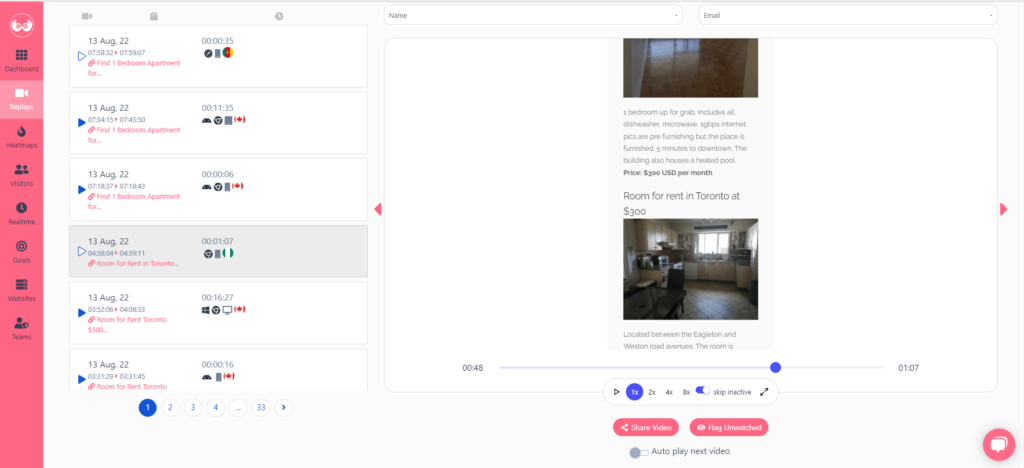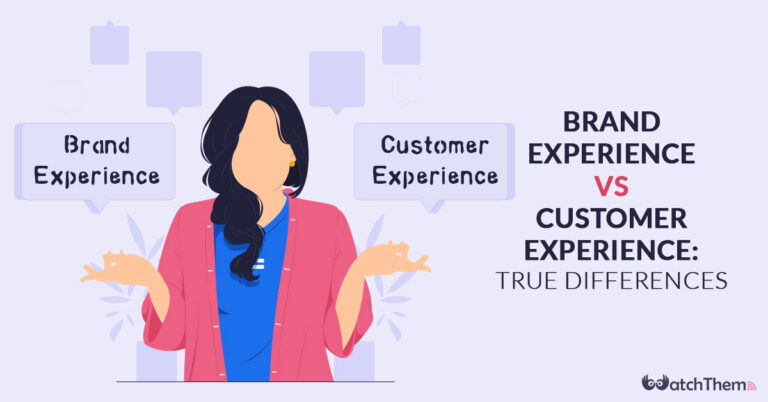Page Contents
As a business owner, you may be wondering whether you should focus on the brand experience or customer experience. After all, they both seem essential. However, you should be aware of some key differences between the two.
A brand is the face of a company. It’s what customers see, touch, and feel when they interact with a business. Customer experience, on the other hand, is how those customers feel about their interactions. Though both are important to a company’s success, they are not the same thing. Here’s a closer look at the difference between brand experience and customer experience.
Note: WatchThemLive is one of the best behavior analytics tools that can assist you in gathering CX data, analyzing it, and figuring out what the drop-off points are and fixing them. Keep on reading to learn how!
What Is Brand Experience?
Brand experience (BX) refers to individuals’ real sensations, thoughts, and reactions in response to a brand. It is all about how users feel in their interactions with a brand and how they feel when they see your brand name and minimalistic logo design.
Brand experience is subjective and can be significantly different between individuals since each person has different experiences that the brand evokes; it can be entirely positive for one person and totally negative for another one. As a motivator to enter the product development process, you need to expand the brand experience.
Normally, businesses’ purpose is to reinforce their brand and provide their customers with opportunities for brand experience. Customers can experience the brand, from marketing materials to customer satisfaction.
Brand Experience Importance
In today’s competitive landscape, it is more important than ever to create a positive brand experience for your customers. This can be done in a number of ways, such as ensuring your products or services are easy to use or providing outstanding customer service. Creating a positive brand experience will not only improve customer satisfaction but can also lead to increased brand loyalty and advocacy. So if you’re looking to manage the evolution of your brand successfully, make sure you’re paying close attention to the brand experience you’re providing.
Additionally, as customers’ expectations are rapidly rising, it has become increasingly important for organizations to be able to deliver a consistent brand experience across all touchpoints. Brand experience measurement can help brands to ensure that they are living up to customer expectations and also anticipate and influence new directions in brand experience.
Brand experience is important because it:
- Engages new customers
- Re-engages existing customers
- Facilitates deeper connections
- Stays fresh and relevant over time
- Stands against competitors
- Inspires audience
- Causes positive responses
- Creates customer loyalty.
Anyhow, considering all the mentioned points, still creating a consistent brand experience is crucial. Brand consistency helps to create lasting customer relationships and can increase brand recognition. Some companies invest all their time and attention on a few big experiences and ignore the importance of consistency. On the contrary, some others only focus on consistency and do nothing more. To succeed in having a great brand experience, you need to make sure you take the middle road and consider both as important elements.
What Is Customer Experience?
In business, the customer experience is the sum of all interactions a customer has with a company, including everything from awareness and discovery to purchase and post-purchase. A great customer experience is important because it helps create brand loyalty and repeat customers.
A bad customer experience, on the other hand, can be really destructive. It can lead to negative reviews, social media backlash, and loss of customers. That’s why it’s so important for businesses to focus on creating a positive customer experience.
There are a few key things that businesses should keep in mind when trying to create a great customer experience. First, they need to make sure their employees are trained and equipped to deal with customers. Second, they need to have systems and processes in place to deal with customer issues quickly and efficiently.
Using a customer behavior, analytics tool such as WatchThemLive paves the road for you to get more loyal customers and increase revenue. By using features like session replays, for example, you can record your customers’ interactions with your website and solve any possible issues.


Sign up and get started with WatchThemLive’s session replays now!
Is Brand Experience and Customer Experience the Same Thing?
We have already talked about the brand experience (BX) and customer experience (CX), but we haven’t yet discussed the differences between these two. Well, both of them are absolutely important in the success and reputation of a business and are closely connected; still, they are two different things. The difference between brand experience and the customer experience in the simplest possible way can be explained by “promise”. Brand experience is basically about making promises, but customer experience is about keeping the promises. The brand team is in charge of delivering promises to the market with an excellent brand experience strategy and attracting new potential customers. After converting the potential customers, customer experience team roles in and provides them the best possible experience and delivers what they have been promised by the BX team.
Another difference is that brand experience is a long-term strategy that develops over time. Customer experience is more immediate due to the instant reactions from the customers. Look at what other things each term includes:
| Brand Experience | Customer Experience |
| long-term | Immediate |
| User Interface | User Experience |
| Marketing | Service |
| Activation | Support |
| Engagement | Satisfaction |
How Does Branding Affect Customer Experience?
In an increasingly competitive market, businesses must focus on creating a strong customer experience to stand out. A company’s brand can have a profound effect on a customer’s experience, which can be a positive, or negative effect.
A strong, positive brand can create an emotional connection with customers and build loyalty that extends beyond the individual product or service.
On the other hand, a weak or negative brand can repel customers and leave them feeling unfulfilled.
Going through the appropriate branding process can create an experience that is significantly beneficial; customers feel good about it and are proud to be associated with the brand. The happier your customers get, the more likely they are to recommend you to others. The opposite is also true, when a company’s branding is off-target, there will be negative impacts on the customer experience. You will face disappointed customers who are unwilling to interact with your brand.
Conclusion
In conclusion, it is important to understand the difference between customer and brand experience and to use them together to create a great result for your business. By knowing the different aspects of these experiences and how they can be used together, you can create a positive relationship with your customers that will keep them coming back. Knowing that not many people are aware of the differences between brand and customer experience, you can make the best use of it and step ahead of all your competitors. Meanwhile, keep in mind that creating an effective customer experience needs a behavior analytics tool like WatchThemLive that enables you to focus better on customer experience. Sign up and see yourself!


